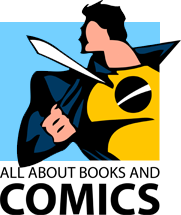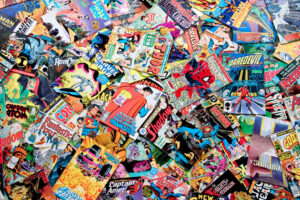Next-to-the-last week for Convergence, but now Marvel’s Secret Wars tie-ins start this week (although there’s no issue of the main title); in addition, a ton of indy books came out, from Optic Nerve to Wytches to Lumberjanes to Powers, so let’s dive in:
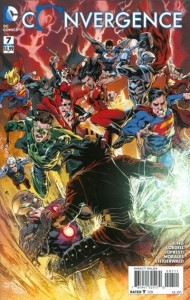 Convergence #7 (of 8) — Writers: Jeff King and Scott Lobdell; Pencils: Aaron Lopresti; Inks: Mark Morales; Colors: Peter Steigerwald
Convergence #7 (of 8) — Writers: Jeff King and Scott Lobdell; Pencils: Aaron Lopresti; Inks: Mark Morales; Colors: Peter Steigerwald
Convergence: Batman and the Outsiders #2 (of 2) — Writer: Marc Andreyko; Art: Carlos D’Anda; Colors: Gabe Eltaeb
Convergence: The Flash #2 (of 2) — Writer: Dan Abnett; Art: Federico Dallocchio; Colors: Veronica Gandini
Convergence: Green Lantern Corps #2 (of 2) — Writer: David Gallaher; Pencils: Steve Ellis; Inks: Ande Parks; 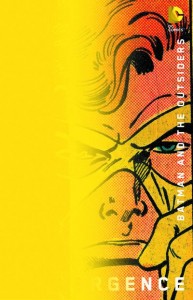 Colors: Hi-Fi
Colors: Hi-Fi
Convergence: Hawkman #2 (of 2) — Writer: Jeff Parker; Pencils: Tim Truman; Inks: Enrique Alcatena; Colors: John Kalisz
Convergence: Justice League of America #2 (of 2) — Writer: Fabian Nicieza; Art: Chriscross; Colors: Snakebite Cortez
Convergence: Superboy and the Legion of Super-Heroes #2 (of 2) — Writer: Stuart Moore; Layouts: Peter Gross; Finishes: Mark Farmer; Colors: John Rauch
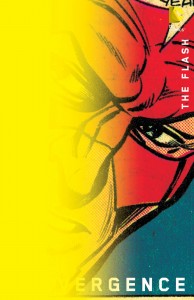 Convergence: Adventures of Superman #2 (of 2) — Writer: Marv Wolfman; Pencils: Roberto Viacava; Inks: Andy Owens; Colors: Sotocolor
Convergence: Adventures of Superman #2 (of 2) — Writer: Marv Wolfman; Pencils: Roberto Viacava; Inks: Andy Owens; Colors: Sotocolor
Convergence: Swamp Thing #2 (of 2) — Writer: Len Wein; Art: Kelley Jones; Colors: Michelle Madsen
Convergence: New Teen Titans #2 (of 2) — Writer: Marv Wolfman; Pencils: Nicola Scott; Inks: Marc Deering; Colors: Jeromy Cox
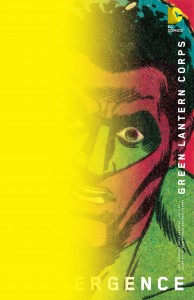 Convergence: Wonder Woman #2 (of 2) — Writer: Larry Hama; Pencils: Aaron Lopresti; Inks: Matt Banning; Colors: Tanya and Richard Horie
Convergence: Wonder Woman #2 (of 2) — Writer: Larry Hama; Pencils: Aaron Lopresti; Inks: Matt Banning; Colors: Tanya and Richard Horie
Besides the main title, the concluding issues of all the yellow-washed covers — the ones involving DC characters from thirty years ago, right before Crisis on Infinite Earths — are here; as with the other #2s, each has a preview of one of DC’s titles for June, so follow along to see which new book goes with which comic. Convergence itself offers its 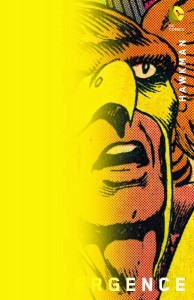 penultimate issue; naturally, it’s mostly a huge fight scene, as the various good and bad characters battle it out, and it ends with a, literally (well, I guess figuratively, since fiction can’t be literal. Sorry — English teacher thinking…) multiverse-shattering development. Is everyone dead? Will DC now just close up shop and cease publishing? The odds don’t exactly favor that, but tune in next week to see…. Meanwhile, in the tie-ins, Batman and the Outsiders fight various characters from Kamandi’s world, with Carlos D’Anda’s precisely-rendered art elevating the story above average; the preview is of the new Batman Beyond (the one
penultimate issue; naturally, it’s mostly a huge fight scene, as the various good and bad characters battle it out, and it ends with a, literally (well, I guess figuratively, since fiction can’t be literal. Sorry — English teacher thinking…) multiverse-shattering development. Is everyone dead? Will DC now just close up shop and cease publishing? The odds don’t exactly favor that, but tune in next week to see…. Meanwhile, in the tie-ins, Batman and the Outsiders fight various characters from Kamandi’s world, with Carlos D’Anda’s precisely-rendered art elevating the story above average; the preview is of the new Batman Beyond (the one 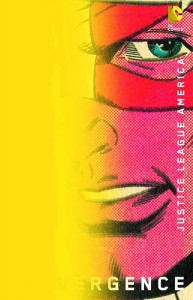 which, thanks to events in Futures End, now has Tim Drake in the title role, trapped in a now-dystopian future), written by Dan Jurgens and with art by Bernard Chang. The Flash has Barry Allen fighting the Superman from the Tangent universe (the psychic-powers one who looks like a cross between the Dalai Lama and Luke Cage), in a very smart script by Dan Abnett that manages to do justice to both characters; the preview is of New Suicide Squad, by Sean Ryan and Philippe Briones. Green Lantern Corps has Hal Jordan and John Stewart fighting the super-powerful Anti-God from the Kamandi future — but it’s really a Guy
which, thanks to events in Futures End, now has Tim Drake in the title role, trapped in a now-dystopian future), written by Dan Jurgens and with art by Bernard Chang. The Flash has Barry Allen fighting the Superman from the Tangent universe (the psychic-powers one who looks like a cross between the Dalai Lama and Luke Cage), in a very smart script by Dan Abnett that manages to do justice to both characters; the preview is of New Suicide Squad, by Sean Ryan and Philippe Briones. Green Lantern Corps has Hal Jordan and John Stewart fighting the super-powerful Anti-God from the Kamandi future — but it’s really a Guy 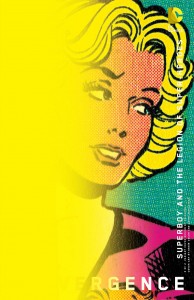 Gardner story, and fans of that character will want to read it. The preview features Gotham Academy, written by Becky Cloonan and Brenden Fletcher, and with art by Mingjue Helen Chen; it’s a welcome adolescent-friendly book, with a quirky and entertaining style, and DC’s giving it a big push in their ads, so this is a good opportunity to experience its charm. Hawkman continues to be worthwhile because of the excellent Tim Truman art, equal parts otherworldly and gritty, and because writer Jeff Parker gives him a script tailored exactly to his strengths; the preview is of Grayson, which has a new, less-shady iteration of the secret-agent Spyral organization, with story by Tom King and Tim Seeley, and
Gardner story, and fans of that character will want to read it. The preview features Gotham Academy, written by Becky Cloonan and Brenden Fletcher, and with art by Mingjue Helen Chen; it’s a welcome adolescent-friendly book, with a quirky and entertaining style, and DC’s giving it a big push in their ads, so this is a good opportunity to experience its charm. Hawkman continues to be worthwhile because of the excellent Tim Truman art, equal parts otherworldly and gritty, and because writer Jeff Parker gives him a script tailored exactly to his strengths; the preview is of Grayson, which has a new, less-shady iteration of the secret-agent Spyral organization, with story by Tom King and Tim Seeley, and 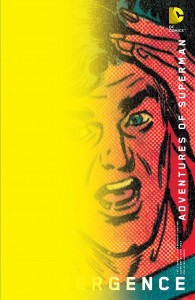 art by Mikel Janin. Justice League of America concludes its tale of the Detroit-era versions of those characters fighting the Tangent-universe Secret Six, with the Chriscross art its best feature; the preview is one of the most intriguing, as it offers Batman/Superman, but with the vastly-powered-down Clark Kent and the armored-up James Gordon in those roles, and acting much more as adversaries than friends.
art by Mikel Janin. Justice League of America concludes its tale of the Detroit-era versions of those characters fighting the Tangent-universe Secret Six, with the Chriscross art its best feature; the preview is one of the most intriguing, as it offers Batman/Superman, but with the vastly-powered-down Clark Kent and the armored-up James Gordon in those roles, and acting much more as adversaries than friends.
Halfway through — Superboy and the Legion of Super-Heroes has that team against the Atomic Knights, in a story that has to bend over backwards to make it an interesting fight, and offers a look at June’s Teen Titans, by Will 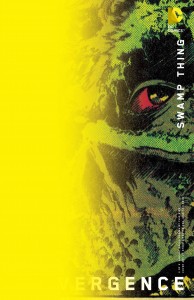 Pfeifer and Kenneth Rocafort, with Superboy wanted for murder and Wonder Girl leaving the team. Adventures of Superman offers the pleasures of a Marv Wolfman script, especially because it focuses as much on the original Supergirl as on her older cousin, and acts as a sort of prequel to Crisis on Infinite Earths (written, of course, by Wolfman himself, thirty years ago, and which killed off that character permanently). The preview is of the new Martian Manhunter, by Rob Williams and with art by Eddy Barrows, as J’onn J’onzz has his green hands full battling an alien invasion — from Mars. Swamp
Pfeifer and Kenneth Rocafort, with Superboy wanted for murder and Wonder Girl leaving the team. Adventures of Superman offers the pleasures of a Marv Wolfman script, especially because it focuses as much on the original Supergirl as on her older cousin, and acts as a sort of prequel to Crisis on Infinite Earths (written, of course, by Wolfman himself, thirty years ago, and which killed off that character permanently). The preview is of the new Martian Manhunter, by Rob Williams and with art by Eddy Barrows, as J’onn J’onzz has his green hands full battling an alien invasion — from Mars. Swamp 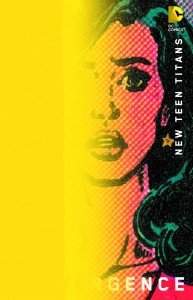 Thing continues to be the best of all the Convergence tie-ins, as Swampy is fighting the Gotham vampires from the Batman Elseworlds Red Rain (including a fanged, and conflicted, Batman himself), because of its Len Wein script (Wein having created Swamp Thing 44 years ago) and Wrightsonesque, picture-perfect Kelley Jones art; The preview is of Catwoman, by Genevieve Valentine and David Messina. New Teen Titans is by Wolfman again (who originated that series, too, at least in its ’80s “new” version, and it’s nice to see those characters get some airtime once more), as they
Thing continues to be the best of all the Convergence tie-ins, as Swampy is fighting the Gotham vampires from the Batman Elseworlds Red Rain (including a fanged, and conflicted, Batman himself), because of its Len Wein script (Wein having created Swamp Thing 44 years ago) and Wrightsonesque, picture-perfect Kelley Jones art; The preview is of Catwoman, by Genevieve Valentine and David Messina. New Teen Titans is by Wolfman again (who originated that series, too, at least in its ’80s “new” version, and it’s nice to see those characters get some airtime once more), as they 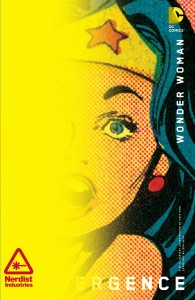 fight the Tangent universe Doom Patrol; the preview is of Robin, Son of Batman, with the just-revived Damian Wayne character now solo (his father having “died”); it’s written and drawn by Patrick Gleason, and offers a double-page splash that’s very well done, and indicates that this might be a tile worth following. Finally, Wonder Woman has Diana Prince battling the vampire Joker from Red Rain, in a story with a serious body count. The preview is of the Gail Simone-written Secret Six, with art by Dale Eaglesham; that’s always been a book worth reading, and looks like it will continue to be.
fight the Tangent universe Doom Patrol; the preview is of Robin, Son of Batman, with the just-revived Damian Wayne character now solo (his father having “died”); it’s written and drawn by Patrick Gleason, and offers a double-page splash that’s very well done, and indicates that this might be a tile worth following. Finally, Wonder Woman has Diana Prince battling the vampire Joker from Red Rain, in a story with a serious body count. The preview is of the Gail Simone-written Secret Six, with art by Dale Eaglesham; that’s always been a book worth reading, and looks like it will continue to be.
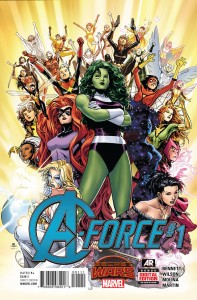 Secret Wars: A-Force #1 — Writers: Marguerite Bennett and G. Willow Wilson; Pencils: Jorge Molina; Inks: Jorge Molina and Craig Yeung; Colors: Laura Martin and Matt Milla
Secret Wars: A-Force #1 — Writers: Marguerite Bennett and G. Willow Wilson; Pencils: Jorge Molina; Inks: Jorge Molina and Craig Yeung; Colors: Laura Martin and Matt Milla
Secret Wars: Battleworld #1 (of 4) — (First Story) Writer: Joshua Williamson; Art: Mike Henderson; Colors: Jordan Boyd; (Second Story): Writer: Ed Brisson; Art: Scott Hepburn; Colors: Matt Milla
Secret Wars: Ultimate End #1 (of 5) — Writer: Brian Michael Bendis; Pencils: Mark Bagley; Inks: Scott Hanna; 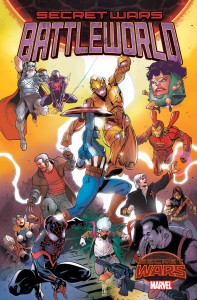 Colors: Justin Ponsor
Colors: Justin Ponsor
Secret Wars: Spider-Verse #1 — Writer: Mike Costa; Art: Andre Aravjo; Colors: Rachelle Rosenberg
Secret Wars: Master of Kung Fu #1 (of 4) — Writer: Haden Blackman; Pencils: Dalibor Talajic; Inks: Goran Sudzuka; Colors: Miroslav Mrva
Secret Wars: Planet Hulk #1 — Writer: Sam Humphries; Art: Marc Laming; Colors: Jordan Boyd
Loki: Agent of Asgard #14 — Writer: Al Ewing; Art: Lee 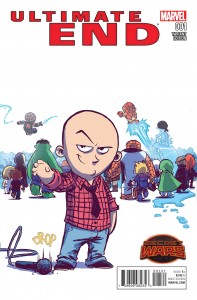 Garbett; Colors: Antonio Fabela with Andres Mossa
Garbett; Colors: Antonio Fabela with Andres Mossa
As I said at the top, there’s no issue of the main Secret Wars this week, but a number of tie-ins are beginning; they’re all set on Battleworld, the cobbled-together remnants of the Marvel multiverse, and explore different areas of that Dr. Doom-ruled hodgepodge of timelines and multiple-character variations. A-Force is the one that’s going to continue after the crossover dust settles; it looks at 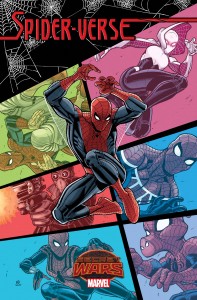 Arcadia, a section of the planet made up almost entirely of various super-powered women; a look at the cover will give you an idea of the lineup, although the Young Avengers character Miss America has the biggest story arc in this debut issue. It’s well-written and looks good, and Marvel’s giving it a big push this summer, so it’s worth getting in on its ground floor. Battleworld is an anthology book, with two different stories: the first involves the Punisher against a quartet from the demonic Inferno section of the planet: variations of Hulk, Wolverine, Spider-Man and Ghost Rider (the same team that was the Fantastic Four for three issues in the ’90s), while the second
Arcadia, a section of the planet made up almost entirely of various super-powered women; a look at the cover will give you an idea of the lineup, although the Young Avengers character Miss America has the biggest story arc in this debut issue. It’s well-written and looks good, and Marvel’s giving it a big push this summer, so it’s worth getting in on its ground floor. Battleworld is an anthology book, with two different stories: the first involves the Punisher against a quartet from the demonic Inferno section of the planet: variations of Hulk, Wolverine, Spider-Man and Ghost Rider (the same team that was the Fantastic Four for three issues in the ’90s), while the second 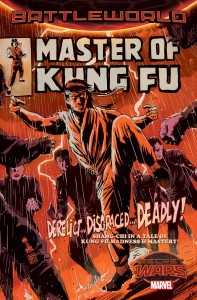 has a bunch of interdimensional versions of Modok getting together, with predictably-chaotic results. Ultimate End is set in a version of Manhattan where both “our” Avengers and the Ultimate versions of all those characters ended up; it’s worth noting because it’s by Bendis and Bagley, who were responsible for Ultimate Spider-Man all those years, making them the right choice for, as the title says, the last story involving most of the Ultimate people (and the Scottie Young variant cover, featuring Bendis himself, is absolutely the one to look for). Spider-Verse builds on that just-concluded crossover story: a section of Battleworld where various iterations of Spider-Man live: the Gwen Stacy one, a
has a bunch of interdimensional versions of Modok getting together, with predictably-chaotic results. Ultimate End is set in a version of Manhattan where both “our” Avengers and the Ultimate versions of all those characters ended up; it’s worth noting because it’s by Bendis and Bagley, who were responsible for Ultimate Spider-Man all those years, making them the right choice for, as the title says, the last story involving most of the Ultimate people (and the Scottie Young variant cover, featuring Bendis himself, is absolutely the one to look for). Spider-Verse builds on that just-concluded crossover story: a section of Battleworld where various iterations of Spider-Man live: the Gwen Stacy one, a 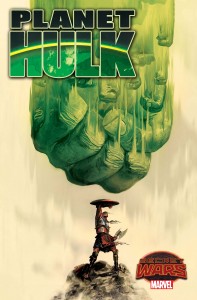 Captain Britain one, the Anya Corazon one, and the one from India — plus a fifth, surprise reveal (although a look at the cover will help your guessing considerably). Master of Kung Fu looks at K’un Lun, a section of Battleworld where all the Oriental characters ended up, in a jumbled past where the Iron Fists, Fu Manchus (although Marvel can’t use that name, for licensing reasons) and Mandarins all have a tangled history, and an outcast Shang Chi ends up fighting for justice against most of them; it’s much better than I expected, especially if you have a soft spot for all of those ’70s Kung Fu-inspired characters. Finally, Planet Hulk is
Captain Britain one, the Anya Corazon one, and the one from India — plus a fifth, surprise reveal (although a look at the cover will help your guessing considerably). Master of Kung Fu looks at K’un Lun, a section of Battleworld where all the Oriental characters ended up, in a jumbled past where the Iron Fists, Fu Manchus (although Marvel can’t use that name, for licensing reasons) and Mandarins all have a tangled history, and an outcast Shang Chi ends up fighting for justice against most of them; it’s much better than I expected, especially if you have a soft spot for all of those ’70s Kung Fu-inspired characters. Finally, Planet Hulk is 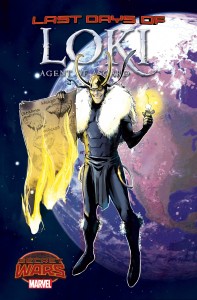 exactly what you think it is: the gamma-ray quadrant of the planet (called, heh, Greenland), with lots and lots of Hulks and their associates; you have to like a book that doesn’t start off there, but with a Captain America/Devil Dinosaur team-up instead. Finally, while Loki isn’t set on Battleworld — it takes place just as everything’s falling apart, which to the Asgardians plays out as Ragnarok — it’s so tied into the events, and offers such cool versions of the characters — including a cranky but kick-ass Odin, and both the old evil Loki and the new, gender-switching one who’s realized that, lies being just another term for fiction, he/she can be the God of Stories — that it shouldn’t be missed.
exactly what you think it is: the gamma-ray quadrant of the planet (called, heh, Greenland), with lots and lots of Hulks and their associates; you have to like a book that doesn’t start off there, but with a Captain America/Devil Dinosaur team-up instead. Finally, while Loki isn’t set on Battleworld — it takes place just as everything’s falling apart, which to the Asgardians plays out as Ragnarok — it’s so tied into the events, and offers such cool versions of the characters — including a cranky but kick-ass Odin, and both the old evil Loki and the new, gender-switching one who’s realized that, lies being just another term for fiction, he/she can be the God of Stories — that it shouldn’t be missed.
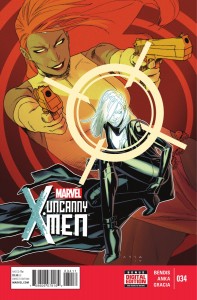 Uncanny X-Men #34 — Writer: Brian Michael Bendis; Art: Kris Anka; Colors: Marte Gracia
Uncanny X-Men #34 — Writer: Brian Michael Bendis; Art: Kris Anka; Colors: Marte Gracia
Powers #3 — Writer: Brian Michael Bendis; Art: Michael Avon Oeming; Colors: Nick Filardi
Two more by Bendis — Uncanny X-Men is almost his last issue of that title, after a long run both on it and its sister title All-New X-Men; one more issue, #35, is due out next month, and then the culmination, #600, is out in October, after all the Secret Wars dust has settled. Here, Bendis is 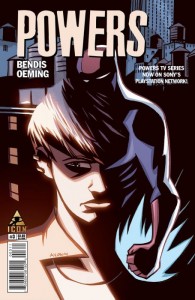 tidying up old plot threads, as Dazzler settles scores with Mystique, and the new X-kids realize that, Scott Summers having quit as their teacher, they’re free to do… something else. Powers, meanwhile, has seen its police-procedural-plus-superpowers tale become at least a modest hit on Playstation, and continues to be worth reading because of Oeming’s unique art, and the hardboiled precinct-house dialogue and style that’s let it last for more than fifteen years now.
tidying up old plot threads, as Dazzler settles scores with Mystique, and the new X-kids realize that, Scott Summers having quit as their teacher, they’re free to do… something else. Powers, meanwhile, has seen its police-procedural-plus-superpowers tale become at least a modest hit on Playstation, and continues to be worth reading because of Oeming’s unique art, and the hardboiled precinct-house dialogue and style that’s let it last for more than fifteen years now.
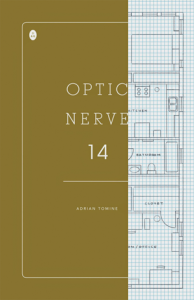 Optic Nerve #14 — Creator: Adrian Tomine
Optic Nerve #14 — Creator: Adrian Tomine
Valhalla Mad #1 — Writer: Joe Casey; Art/Colors: Paul Maybury
Stray Bullets #4 — Creator: David Lapham
Wytches #6 — Writer: Scott Snyder; Art: Jock; Colors: 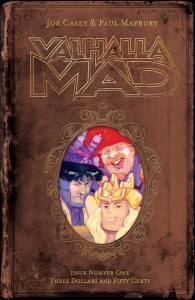 Matt Hollingsworth
Matt Hollingsworth
Satellite Sam #14 — Writer: Matt Fraction; Art: Howard Chaykin
The Goon: Once Upon a Hard Time #3 (of 4) — Creator: Eric Powell
The Fade-Out #6 — Writer: Ed Brubaker; Art: Sean 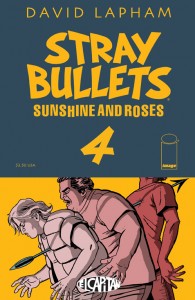 Phillips; Colors: Elizabeth Breitweiser
Phillips; Colors: Elizabeth Breitweiser
Usagi Yojimbo #145 — Creator: Stan Sakai
Groo: Friends and Foes #5 (of 12) — Creator: Sergio Aragones; Wordsmith: Mark Evanier; Colors: Michael Atiyeh and Caitlin McCarthy
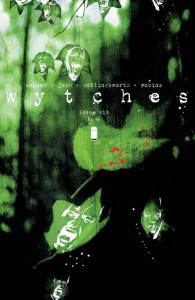 Lumberjanes #14 — Writers: Noelle Stevenson and Shannon Watters; Art: Brooke Allen; Colors: Maarta Laiho
Lumberjanes #14 — Writers: Noelle Stevenson and Shannon Watters; Art: Brooke Allen; Colors: Maarta Laiho
A bunch of high-quality indy books this week, but we’re almost out of space, so let’s look at them quickly. Adrian Tomine does maybe one Optic Nerve a year, if we’re lucky 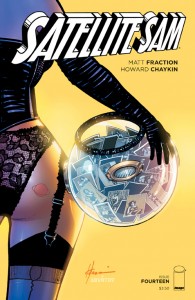 (the first one came out twenty years ago, and this newest one is number fourteen). This issue offers two tales: one about a young woman who stutters, and wants to take a class in stand-up comedy; it focuses on her relationship with her father, and is about equal parts wince-inducing (especially during her first routine in front of an actual comedy-club audience), funny and tender. The other’s about a guy who comes across a spare set of keys to his former
(the first one came out twenty years ago, and this newest one is number fourteen). This issue offers two tales: one about a young woman who stutters, and wants to take a class in stand-up comedy; it focuses on her relationship with her father, and is about equal parts wince-inducing (especially during her first routine in front of an actual comedy-club audience), funny and tender. The other’s about a guy who comes across a spare set of keys to his former 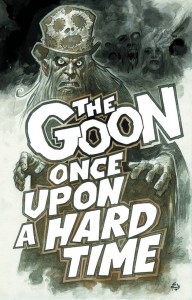 apartment, and finds out they still fit the lock, after which he goes in when the new tenant isn’t there, with odd results. Both are very high-quality slice-of-life stories, sophisticated and perceptive (you could see them appearing as prose short stories in the New Yorker, a magazine Tomine has done covers for), and well worth reading. Valhalla Mad is the only first issue of the bunch; it’s Joe Casey channeling Jack
apartment, and finds out they still fit the lock, after which he goes in when the new tenant isn’t there, with odd results. Both are very high-quality slice-of-life stories, sophisticated and perceptive (you could see them appearing as prose short stories in the New Yorker, a magazine Tomine has done covers for), and well worth reading. Valhalla Mad is the only first issue of the bunch; it’s Joe Casey channeling Jack 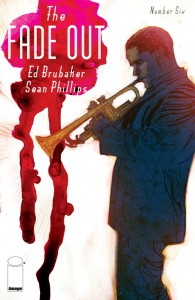 Kirby doing the Warriors Three, and is derivative but manages some of the King’s high-octane energy. Stray Bullets is its regular noir self, one of those long-standing titles whose blood-soaked tales of mostly-bad people is dependably entertaining, while Wytches seems to be a suitably-apocalyptic conclusion to the whole book. Snyder says in the editorial material, though, that it’s really just the end of the first arc, and eventually they’ll be back —
Kirby doing the Warriors Three, and is derivative but manages some of the King’s high-octane energy. Stray Bullets is its regular noir self, one of those long-standing titles whose blood-soaked tales of mostly-bad people is dependably entertaining, while Wytches seems to be a suitably-apocalyptic conclusion to the whole book. Snyder says in the editorial material, though, that it’s really just the end of the first arc, and eventually they’ll be back — 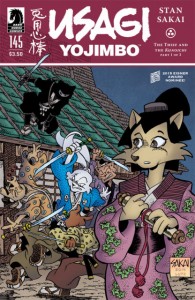 although, true to horror-story form, only one of the original characters seems to have made it through in one piece. Satellite Sam offers its penultimate issue, wherein a number of plot points get resolved, and no one ends up particularly happy; we’ll have to see how the coda leaves everyone next issue, although, as always, the Chaykin art makes everything look great. Both The Goon and The Fade-Out offer noirish tales, with The Goon’s considerably more
although, true to horror-story form, only one of the original characters seems to have made it through in one piece. Satellite Sam offers its penultimate issue, wherein a number of plot points get resolved, and no one ends up particularly happy; we’ll have to see how the coda leaves everyone next issue, although, as always, the Chaykin art makes everything look great. Both The Goon and The Fade-Out offer noirish tales, with The Goon’s considerably more 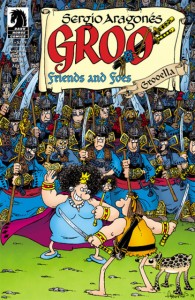 over-the-top and Gothic/supernatural, while The Fade-Out is more in Raymond Chandler territory, with the bright sunlight of LA and Hollywood concealing all manner of shadowy sins. Finally, a trio of comics that are kid-friendly: Usagi Yojimbo is Stan Sakai’s welcome return to his long-eared samurai, and offers its usual mix of talking animals, careful research into feudal Japan and skillfully-plotted drama, while Groo is much more slapstick
over-the-top and Gothic/supernatural, while The Fade-Out is more in Raymond Chandler territory, with the bright sunlight of LA and Hollywood concealing all manner of shadowy sins. Finally, a trio of comics that are kid-friendly: Usagi Yojimbo is Stan Sakai’s welcome return to his long-eared samurai, and offers its usual mix of talking animals, careful research into feudal Japan and skillfully-plotted drama, while Groo is much more slapstick 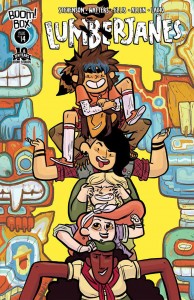 but just as carefully constructed, as the dimwitted barbarian meets his sister, Grooella, and there’s a lot of mistaken identities (some deliberately) and clashings of armies. That leaves Lumberjanes, a comic about a Girl-Scout-like group of girls at a summer camp in a mysterious forest; its cartoony style is more modern-looking than Usagi or Groo (it owes a lot to the heavier lines of a lot of current TV animation), but it’s just as skillful in its blend of humor, drama and lesson-teaching: all the qualities that make a good comic for kids (or, come to think of it, any of the rest of us…)..
but just as carefully constructed, as the dimwitted barbarian meets his sister, Grooella, and there’s a lot of mistaken identities (some deliberately) and clashings of armies. That leaves Lumberjanes, a comic about a Girl-Scout-like group of girls at a summer camp in a mysterious forest; its cartoony style is more modern-looking than Usagi or Groo (it owes a lot to the heavier lines of a lot of current TV animation), but it’s just as skillful in its blend of humor, drama and lesson-teaching: all the qualities that make a good comic for kids (or, come to think of it, any of the rest of us…)..
